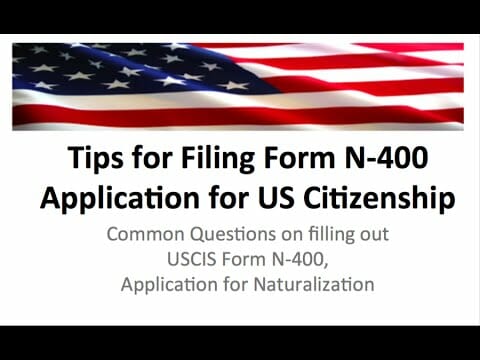Application for Naturalization

Understanding the “Application for Naturalization”
What is Form N-400?
Form N-400 (officially called the “Application for Naturalization”) is a government form used by green card holders who are ready to apply for U.S. citizenship after meeting certain eligibility requirements.
Filing this form with U.S. Citizenship and Immigration Services (USCIS), which is part of the U.S. Department of Homeland Security (DHS), is the first step of “naturalization” the process of becoming an American Citizen.
N-400 Eligibility
Q: Who can file Form N-400?
A: Only individuals who have satisfied the eligibility requirements for naturalization may file an N-400. In general, you must be at least 18 years old and have had a green card for five years (or three years if you’re married to a U.S. citizen).
N-400 Basics
Q: How much does it cost to file Form N-400?
A: The current government fee for filing an N-400 is $725.
Q: How long does it take to process Form N-400?
A: The current average processing time for naturalization applications is a little over 10 months.
Filing Early
The 90-day early-filing rule: You may file your naturalization application with USCIS as early as 90 days before the end of your three- or five-year wait period as a green card holder — as long as you’ve met all other eligibility criteria.
N-400 Required Document
All naturalization applicants must include supporting documents with their Form N-400. Required documents for all applicants include:
- A copy of your green card (Form I-551, officially called the “Permanent Resident Card”)
- Application fee payment (by check or money order, with your A-Number written on the back, or by credit card using Form G-1450)
Some applicants must submit additional supporting documents with their N-400, based on their particular circumstances, including:
- Proof of your current marital status, if you’re married or were previously married (marriage certificate, divorce papers, annulment certificate(s), and/or death certificate(s) for former spouses)
- Two 2-inch-by-2-inch passport-style photos, if you live and are applying from abroad
- Form N-426, officially called the “Request for Certification of Military or Naval Service,” if you’re applying for based on your military service
- Form N-648, officially called the “Medical Certification for Disability Exceptions,” if you’re applying for an exemption to the U.S. citizenship test based on a qualifying medical condition
N-400 Filing Tips
You can follow these tips to help ensure a smooth N-400 application process (if you’re filing by mail):
Do’s:
Do use black ink only. Any missing information or document could delay processing. Worse, it could lead to a denial of your application — based on a new USCIS policy that raises the stakes of completing immigration applications accurately the first time — which means you would need to go through the process again and pay the filing fee a second time.
Do provide translations. If any of your supporting documents was produced in a language other than English, you will need to obtain a certified English translation of that document with your N-400 application.
Don’ts:
Don’t clutter your form. Do not highlight, cross out, or type or write beyond the space provided for your answer. If you need to correct your answer to a question, it’s best to complete a fresh N-400 form. USCIS prefers this instead of using correcting fluid or tape to correct an error. USCIS scans information from the application, and their machines may detect text that’s covered by the correcting fluid or tape, which could potentially lead to errors and processing delays.
Don’t submit unnecessary paperwork. The Form N-400 instructions will clearly indicate which documents are required to be submitted as photocopies versus originals. If you submit original copies of documents that USCIS did not specifically request or require, you may not get these back, as USCIS may destroy them immediately upon receiving them.
Don’t forget to sign! If your signature is missing from your application when USCIS receives it, they will most likely reject (that is, refuse to accept) your application and ask you to send a new one. A recent USCIS policy change, however, makes it imperative to follow all USCIS instructions carefully, as a single mistake or missing document could lead to a denial of your application.
Frequently Asked Questions
Q: What should I do if I’ve moved since filing my application?
A: If you move after filing your N-400, you must notify USCIS within 10 days of relocating to your new address. This ensures that you will not miss any notices that USCIS sends to you by mail.
Q: I’m currently in college. What should I put down on my application as my physical and mailing addresses?
A: The current physical address that you’ll need to use depends on where you plan to attend your future citizenship interview and exam appointment. The location of your appointment will be determined by your ZIP code.
As for your mailing address, you must use the address where you’d like to receive all written correspondence from USCIS. Because these letters contain sensitive information, many people prefer to use their actual home address to receive their mail.
Contact one of our experienced immigration lawyers in New York at 718-407-0871 or online at https://www.prizant-law.com if you need help with Application for Naturalization or any other solutions to your immigration problems.
Contributed by Svetlana Prizant, an Award Winning New York Immigration Lawyer
Call or visit Prizant Law at:
Prizant Law
118-21 Queens Blvd, Suite 507
Forest Hills, NY 11375
